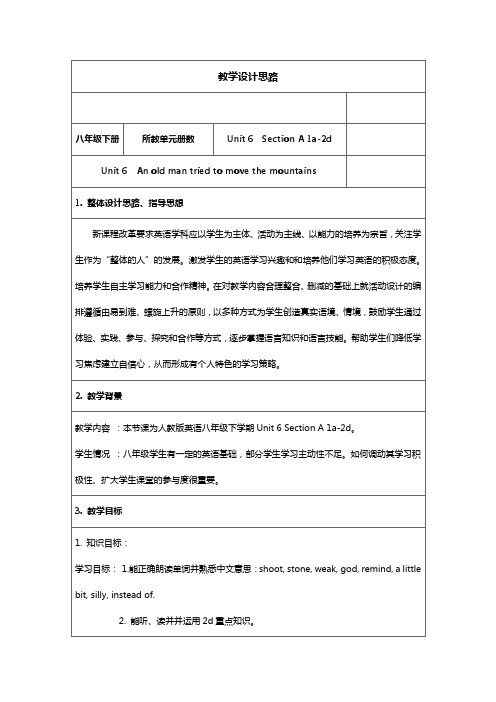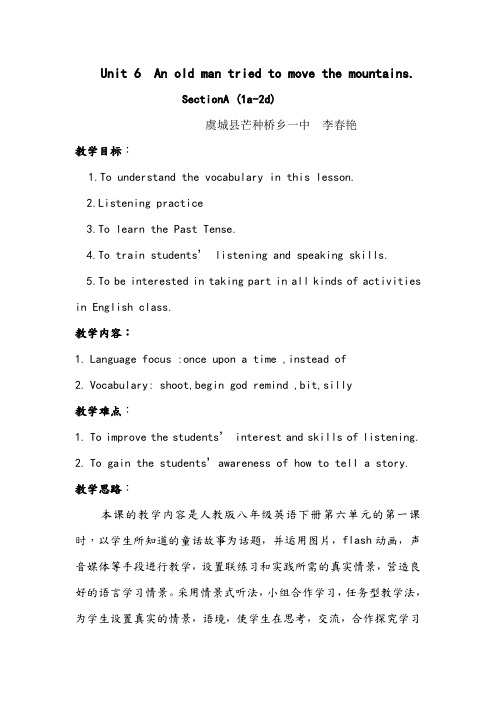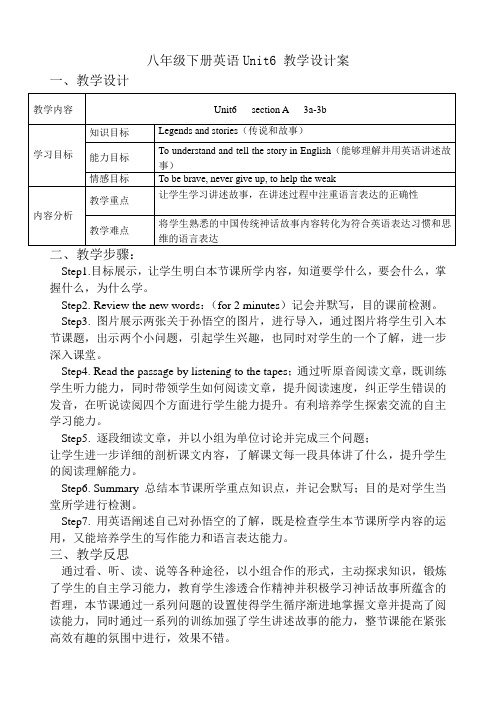初中英语人教版八年级下册第六单元第一课时教学设计
- 格式:doc
- 大小:26.00 KB
- 文档页数:6


Unit 6 An old man tried to move the mountains.SectionA (1a-2d)虞城县芒种桥乡一中李春艳教学目标:1.To understand the vocabulary in this lesson.2.Listening practice3.To learn the Past Tense.4.To train students’ listening and speaking skills.5.To be interested in taking part in all kinds of activities in English class.教学内容:nguage focus :once upon a time ,instead of2.Vocabulary: shoot,begin god remind ,bit,silly教学难点:1.To improve the students’interest and skills of listening.2.To gain the students’awareness of how to tell a story. 教学思路:本课的教学内容是人教版八年级英语下册第六单元的第一课时,以学生所知道的童话故事为话题,并运用图片,flash动画,声音媒体等手段进行教学,设置联练习和实践所需的真实情景,营造良好的语言学习情景。
采用情景式听法,小组合作学习,任务型教学法,为学生设置真实的情景,语境,使学生在思考,交流,合作探究学习中学习和使用语言。
教学准备:Multimedia ,blackboard,tape-recorder教学过程:Step 1 Warming upWatck a fairy tale they know about.Step 2 listening1.Go over the sentences in 1b,and present the new items in them.2.Linten and check the facts you hear.Which story are Anna and Wang Ming talking about?3. Check the students’answers.4.Listen and repeat.Step 3 DiscussingDiscuss the questions in 1c with your paertner.1.How does the story begin?2.What happened next?3.Where would they put all the earth and stone from themountains?Spet 4 Listening1.Present the phrases:work on,move the mountains,as soon as,finish doing,continue to do,so that,take away.2.Listen and number the pictures(1-4) in order to tell thestory in 2a.3.Listen again and circle the words you hear in 2b.4.Check the students’amswers.5.Try to find out how many ways to tell the story.Step 5 Role-playing1.Go over the conversation in 2b,and deak with the difficultiesin groups.Go over the conversation in 2b quickly,if you have any trouble,discuss them in your group.The teacher goes through the classroom and offers help if necessary.2.Read aloud the conversation in pairs.3.Make up their own conversations.4.Act out their conversations in groups,then in class. Step 6 Assignment1.Make sentences with the phrases we learned this class.2.Retell a fairy tale.板书设计:Unit 6 An old man tried to move the mountains.第一课时 Section A(1a-2b)nguage focus:Once upon a time,instead of,work on,move the mountains,as soon as, finish doing, continue to do ,so…that…,take away 2.Vocabulary:shoot,begin,god,remind,bit,silly教学设计虞城县芒种桥乡一中李春艳如何提高英语写作水平英语写作一审”即审题。

八年级下册英语Unit6 教学设计案
一、教学设计
Step1.目标展示,让学生明白本节课所学内容,知道要学什么,要会什么,掌握什么,为什么学。
Step2. Review the new words:(for 2 minutes)记会并默写,目的课前检测。
Step3. 图片展示两张关于孙悟空的图片,进行导入,通过图片将学生引入本节课题,出示两个小问题,引起学生兴趣,也同时对学生的一个了解,进一步深入课堂。
Step4. Read the passage by listening to the tapes;通过听原音阅读文章,既训练学生听力能力,同时带领学生如何阅读文章,提升阅读速度,纠正学生错误的发音,在听说读阅四个方面进行学生能力提升。
有利培养学生探索交流的自主学习能力。
Step5. 逐段细读文章,并以小组为单位讨论并完成三个问题;
让学生进一步详细的剖析课文内容,了解课文每一段具体讲了什么,提升学生的阅读理解能力。
Step6. Summary 总结本节课所学重点知识点,并记会默写;目的是对学生当堂所学进行检测。
Step7. 用英语阐述自己对孙悟空的了解,既是检查学生本节课所学内容的运用,又能培养学生的写作能力和语言表达能力。
三、教学反思
通过看、听、读、说等各种途径,以小组合作的形式,主动探求知识,锻炼了学生的自主学习能力,教育学生渗透合作精神并积极学习神话故事所蕴含的哲理,本节课通过一系列问题的设置使得学生循序渐进地掌握文章并提高了阅读能力,同时通过一系列的训练加强了学生讲述故事的能力,整节课能在紧张高效有趣的氛围中进行,效果不错。



Unit 6 An Old Man Tried to Move the Mountains 教材分析
教材分析:
本单元是新目标教材的八年级英语下册的第六单元,包括四个板块的内容(Section A, Grammar Focus, Section B, Self Check),本单元的中心话题是“传奇式的童话故事”。
语言技能和语言知识都是依据这一中心话题而设计的。
本单元内容与实际生活息息相关,是学生感兴趣的话题。
因此在教学中,教师应充分调动学生的积极性,鼓励他们大胆开口,运用英语表达与此话题有关的内容。
以此来对学生进行情感态度的培养,并引导学生积极地用英语讲出自己知道的童话故事。
本节课内容主题是中国民间神话故事。
主题图呈现了女娲补天、后羿射日、大闹天空、愚公移山四个家喻户晓的故事。
本课以愚公移山为主线要求学生能够听懂并叙述这则故事,并根据故事相关信息发表观点、运用语言。
Unit 6An old man tried to move the mountains.Section Aand stories”,围绕“传奇式的童话故事”这个话题开展教学活动。
本单元要求学生掌握动词过去式的基本用法,理解课文,熟练运用词汇,了解如何讲述英语故事。
让学生要学会用一般过去时讲述童话故事,培养学生学习英语的兴趣和学习故事中人物身上的优秀品质和精神【Knowledge objectives】在本单元,学生要学会用动词过去式表达做过的事或发生在过去的事;掌握本单元词汇,句型;能够读懂,听懂、掌握和谈论一些著名的童话故事。
【Ability objectives】能听懂语言材料,掌握听的技巧;能就阅读方法提建议,掌握阅读策略;能读懂有关童话故事的文章。
【Moral objectives】通过开展角色表演等活动,培养学生阅读兴趣;通过本单元的阅读,培养学生的文学鉴赏能力,陶冶思想情操。
【Teaching key points】掌握本单元中出现的生词:remind, bit, silly, instead of等;学会询问故事发展的基本句型:How does the story begin?What happened next?学会表达故事中的人物或情节,并发表一些简单的看法或观点。
What do you think of / about the story of Yu Gong?I think it’s a little bit silly.I still don’t agree with you.【Teaching difficulties】学会表达故事中的人物或情节,并发表一些简单的看法或观点。
学习动词的过去式的用法。
Blackboard、Computer for multimedia use.Ⅶ、Teaching procedures:Free talk.Give Ss some pictures about stories to talk about:Which story do you like best?Step1 Warming upShow more stories to talk.Step2 PracticeShow Ss a video about Yu Gong Moves a Mountain.Activity 1a.Match the story with the pictures [a-d].Activity 1b.Listen and check (√) the facts you hear. Which story are Anna and Wang Ming talking about? Tell the story Yu Gong Moves a Mountain to your partner..Activity 1cDiscuss the questions with your partner..Activity 2aListen and number the pictures [1-4] in order to tell the story.Activity 2bListen again and circle the words you hear.Activity 2cLook at the pictures in 2a and tell the story in your own words. Step 3 Free talkWhat can you learn from the story?Step 4 Practicerole-play the conversation.Language points: explain the key words and phrases in section A-1. More exercises about the language points.Ask Ss to talk about Monkey KingStep 5 WatchingShow Ss a video about Monkey KingStep 6 PracticeActivity 3aRead the passage and answer the questions.Read again and summarize the main idea in each paragraph.Activity 3bRead the passage again and plete the chart about the Monkey King. Read again and do true or false.Activity 3cComplete the sentences below with phrases from the passage.Step 7 Free talkDo you like watching Journey to the West?Who do you like best? Why?What do you think about The Monkey King?Step 8 Learn some new words.Language points: explain the key words and phrases in section A-2. More exercises about the language points.Complete the sentences with these conjunctions.Uses of “unless”.Step9 Exercise.Uses of “as soon as” and “so ... that”.Do basic exercise.Step 10 PracticeActivity 4aFill in the blanks with unless, as soon as or so… that.Activity 4bFill in the blanks with the correct forms of the verbs in brackets. Activity 4cTell your partner about your favourite story.More exercises about the grammar.略。
教案
课题
Unit 6 An old man tried to
moved the mountains.课时及授
课时间
1 课时
授课人年月日
教学目标
(学习目标)
1) 能掌握以下单词:remind, bit, silly, instead of
能掌握以下句型:
① How does the story begin?
② What happened next?
③ What do you think of the story of Yu Gong?
④ What could Yu Gong do instead of moving the mountains?
教学重点
1) 掌握本课时中出现的生词:remind, bit, silly, instead of;
2) 学会询问故事发展的基本句型:
How does the story begin?
What happened next?
教学难点学会表达故事中的人物或情节,并发表一些简单的看法或观点。
教学用具
电子白板
教学方法
(学习方法)
The situational teaching approach .task-based language teaching
method ,the gaming teaching method,
教学过程 1.Warming up. 备注
(补充)
板书设计教学反思。
Unit 6 An old man tried to moved the mountains.Section A (1a-1c)教学设计Linda设计主旨:创设教学情境,设计教学任务,激发学生兴趣,鼓励学生参与。
整体设计思路及依据说明:《新目标》八年级下Unit 6的听说读写活动都围绕学生熟悉的中外传说故事展开,这一话题学生熟悉且感兴趣。
本课时是该单元的第一课时,是一节以听说训练为主的新授课。
通过听力引导学生学习《愚公移山》这一传说故事的英语表述,继语言输入过程之后,通过结对活动和小组活动形式完成语言输出:用目标语言讲故事并针对故事情节或主人公发表自己的观点,培养思维能力。
我在设计教学活动时,体现“以学定教”的思想,努力创设教学情境,优化教学过程,激发学生兴趣,使学生能成为学习活动的主人,在活动中大胆交流、合作、创新,并随着层层递进的任务型活动的完成而巩固目标语言。
学生情况分析:八年级学生具有过渡性心理特点,英语学习方面处于两极分化现象开始凸显的阶段,学生的个体差异较大。
因此,在设计教学活动时,我注重层次性,既面向全体,又尊重个体差异,充分调动每个学生的积极性。
传说故事是学生熟悉且感兴趣的话题,因此我设计教学活动时注重引导学生联系已有生活经验,激发他们想学会用英语表述这些故事的欲望,为后来的课堂活动中积极参与语言学习、操练和实践奠定基础。
教法学法:computer-assisted instruction; activity-based teaching, student-centered teaching, task-based learning, communicative approach, pairwork and groupwork.教学目标Language goal:Tell a story.1) Key words and useful expressions:shoot, stone, once upon a time, so…that, instead of.Target language:How does the story begin?Once upon a time, there was a very old ma n…What happened next?Why was Yu Gong trying to move the mountains?Because they were so high and big that it took a long time to walk to the other side.2) Ability Object: Focus on improving Ss’ listening and speaking skills. Enable them to tell the stories using the target languages.3) Moral object:No matter how difficult things are, never give up.Key points:1) Key words:shoot, silly, once upon a time, instead of,s o…that2) Target language:How does the story begin?What happened next?Difficult points: Tell stories using the target language and express theirr own ideas about the stories.Teaching aids: Multimedia courseware.教学过程设计Step 1 Brainstorm1. 多媒体出示有关传说故事的图片,提问学生What interesting stories do these pictures remind you of?导入本单元主题。
第6单元 An old man tried to move the mountains.
Section A 第1课时(1a~2d)
Step1.
明确目标要求 道字乡中学:郭历茹
类别 学习重点
重点单词
shoot, stone, weak, god, remind, bit, silly
重点短语
instead of, work on, take away, a little bit
重点句式
1.But the story is trying to show us that anything is possible if you work hard.
2.As soon as the man finished talking, Yu Gong said that his family could
continue to move the mountains after he died.
3.This story reminds us that you can never know what’s possible unless you
try to make it happen.
Step2.课前自主学习
课
前
预
习
写一写 1.射击;发射shoot 2.石头stone 3.一点;小块bit 4.神;上帝god
5.提醒;使想起remind
6.虚弱的;无力的weak
7.愚蠢的;不明事理的silly
译一译
1.代替;反而instead of (doing sth.)
2.忙于;从事于work on
3.移走;搬走take away
4.有点儿;稍微a little bit
背一背 1.但是这个故事是想告诉我们:只要努力,任何事情都有可能。 But the story is trying to show us that anything is possible if you work hard. 2.这个故事提醒我们,除非你试图让它发生,否则你永远无法知道什么
是可能的。
This story reminds us that you can never know what’s possible unless you
try to make it happen.
Step3.课堂互动探究
新课导入 Teacher:Have you heard of the story called Yu Gong Moves a Mountain? Who can tell
us about the story? Today we are going to talk about the story in English.
新课
展示
【完成教材1a~1c的任务】
1.学生朗读1a中的故事,教师纠正读音,然后背诵并且互相提问。
2.仔细观看图片,你们知道四幅图片涉及的是哪些故事吗?请将图片与1a中的故
事相匹配,完成后集体核对答案。
3.认真听录音,根据听到的内容选出Anna和Wang Ming正在讨论的故事,集体核
对答案。
4.再听一遍录音,并跟读对话。
5.两人一组互相讨论1c中的问题,完成后要求几组学生展示讨论的结果。
【完成教材2a~2d的任务】
1.认真观察2a中的图片,然后听录音,根据听到的顺序为图片标序号,完成后集
体核对答案。
2.再认真听一遍录音,圈出你所听到的单词,完成后集体核对答案。
3.听第三遍录音,学生跟读。
4.两人一组根据图片内容提示及听力信息内容来用自己的语言讲述故事,完成后请
几名学生讲述故事。
5.学生对话并结对练习,分角色表演对话。
【语法提要】
1.instead of
instead of是介词短语,意为“代替;而不是……”,一般在句中,后可跟名词、代
词或动名词。instead of doing sth.“代替做某事”。
例句:He bought a soccer ball instead of a basketball.他买了一个足球而不是篮球。
Let’s go swimming instead of going fishing this time,shall we? 这次我们去游泳而不
去钓鱼,好吗?
instead副词,意为“代替;反而;却”,表示没做前面的事而做了后面的事。作状
语修饰整个句子时,通常位于句末;如果位于句首时,常用逗号隔开。
例句:Jack was ill, so I went instead.杰克病了,因此换了我去。
He never works.Instead, he plays all day and all night.他从不工作,却整日整夜地玩。
instead of与instead
instead of“代替;而不是……”,后可跟名词、代词或动名词。
Let’s play chess instead of watching TV.我们来下棋,不看电视了。
instead“代替;反而;却”,作副词,可修饰整个句子,常位于句首或句末。
I didn’t have breakfast so I ate an apple instead.我没吃早饭,所以吃个苹果来替代。
2.so…that…
此处so…that…引导结果状语从句,意为“如此……以至于……”,so是副词,常
用来修饰形容词或副词。常用句型为:主语+谓语+so+ adj./adv.+ that从句。
例句:She is so young that she can’t look after herself.她如此小以至于不能照顾自己。
He was so angry that he couldn’t say a word.他如此生气以至于说不出一句话。
so that的用法
(1)引导目的状语从句时,意为“以便,为了”,从句中常使用
can/could/may/might/will/would/should等情态动词或助动词。
例句:The little boy saved every coin so that he could buy his mother a present on
Mother’s Day.那个小男孩节约每一分钱以便可以在母亲节为他妈妈买一份礼物。
(2)引导结果状语从句时,意为“因此,所以”,从句中一般不用can和may等词,
so that前可以用逗号。
例句:He works hard so that he won the competition.他学习很努力,所以他赢得了
那次比赛。
【问题探究】
根据汉语意思完成句子。
1.她没有待在家里而去上学了。
She went to school instead of staying at home.
2.He was C nervous he can’t talk in front of the class.
A. such; that
B. too; to
C. so; that
Step4.课堂学以致用
活
学
活
练
1.You will achieve nothing unless(unless/as soon as) you work hard.
2.他是如此的恐惧以至于发不出声音。
He was so scared that he couldn’t make a sound.
3.我可以替我生病的兄弟去开会。
I can go to the meeting instead of my sick brother.
Step5.课后达标检测
布置作业:教师引导学生课后完成本课时对应练习,并预习下一课时内容。
Step6.教学反思
教
学
反
思
本课时主要是锻炼学生听说故事的能力。加强了学生间的互动,让学生在实际
运用中体会到学习英语的快乐。